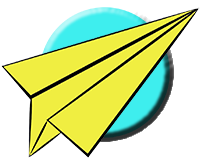Pelican Paper Airplane Step-by-step
Pelican Paper Airplane Step-by-step
Instructions
This interesting looking square craft works best with light to medium weight paper. Start with a letter size sheet.
1. Start with a letter size piece of paper. Fold the paper exactly in half along its long edge. Unfold after the crease has been made.
2.Fold the upper left corner down so the upper left point hits the right edge of the paper. When folded correctly, the top edge should line up with the right edge of the paper. Unfold after the crease has been made.
3.Fold the upper right corner down so the upper right point hits the left edge of the paper. When folded correctly, the top edge should line up with the left edge of the paper. Unfold after the crease has been made.
4. Flip the paper over keeping the creases towards the top.
5.Fold the upper edge of the paper down making a crease which goes through the point in the center formed by the existing diagonal creases.
6.Unfold the paper and lay it flat on the working surface.
7.Flip the paper over, keeping the creases just made towards the top.
8.Pop the left and right horizontal creases up, bringing the points at the ends of the creases in and down towards the center of the paper. When folded correctly, a new flap is formed sticking straight up from the paper's base.
9.Split the layers of the flaps apart bringing the points at the flap tips down towards the point at the edges of the paper. Bring the top point, where the flap meet, straight down and press the whole fold flat.
10. Fold the point at the left edge of the paper up so the point hits the tip at the top of the paper. When folded correctly, the right edge of the newly formed triangle should line up with the center line crease.
11.Open up the first layer of the topmost triangle and bring the point at the top down so it hits the point on the center line crease formed by the upper layers. A new square shaped flap should be formed by this flap.
12.Rotate the paper around so the point at the top is up and to the left.
13.Pop the inside right point of the square flap up and bring it out and up towards the diagonal outside edge of the paper. Two new creases should be formed from the upper right and lower left corners of the square to the existing diagonal crease.
14.Finish this fold by pressing all the layers down and flat against the working surface. Gently pull the new flap out as you close the fold. This is a tricky fold, so take some time to get it right. Note that the new flap should stick out from the diagonal edge of the paper by about one finger width.
15.Fold the point at the right edge of the paper up so the point hits the tip at the top of the paper. When folded correctly, the left edge of the newly formed triangle should line up with the center line crease.
16.Open up the first layer of the topmost triangle and bring the point at the top down so it hits the point on the center line crease formed by the upper layers. A new square shaped flap should be formed by this fold.
17. Rotate the paper around to the point at the top is up and to the right.
18.Pop the inside left point of the square flap up and bring it out and up towards the diagonal outside the edge of the paper. Two new creases should be formed from the upper left and lower right corners of the square to the existing diagonal crease.
19.Finish this fold by pressing all the layers down and flat against the working surface. Pull the new flap out gently as the fold closes. Pull the new flap out as the fold closes. This is a tricky fold so take some time to get it right. Note: try to match the shape and the angle of this flap to the one on the other side of the paper.
20.Rotate the paper around so the nose is up and away. Lay the paper flat on the working surface.
22.Fold the top of two layers of paper up and over to the right. When folded correctly, the point in the lower left corner should hit the center line crease.
21.Fold the point at the tip of the nose down so it hits the center line crease at the point formed by the existing layers of the paper.
23. Fold the top two layers of paper up and over to the left. When folded correctly, the point in the lower right corner should hit the center line crease.
24. Rotate the paper around so the nose is to the left.
25. Fold the paper exactly in half about the existing center line crease. Be sure to line the wing flaps for good balance.
26.Make a crease for the first wing flap. The left point of the crease should be about one finger width up from the bottom edge of the fuselage and the right point should be about two finger widths up from the bottom.
27.Flip the plane over so the first wing flap is underneath and the nose points to the left.
28.Make a crease for the second wing flap. Be sure to line up the wing flaps for good balance.
29. Open up the wing flaps and adjust the wing angles so they are even. Make sure to adjust the dihedral angle flat or slightly upward.
THE THROW Launch gently at a slight up angle. With its large wing area, this craft will float and can remain airborne for lone periods of time. In addition to the usual elevator adjustments, the nose flaps can be adjusted to create acrobatic and less stable flights.
